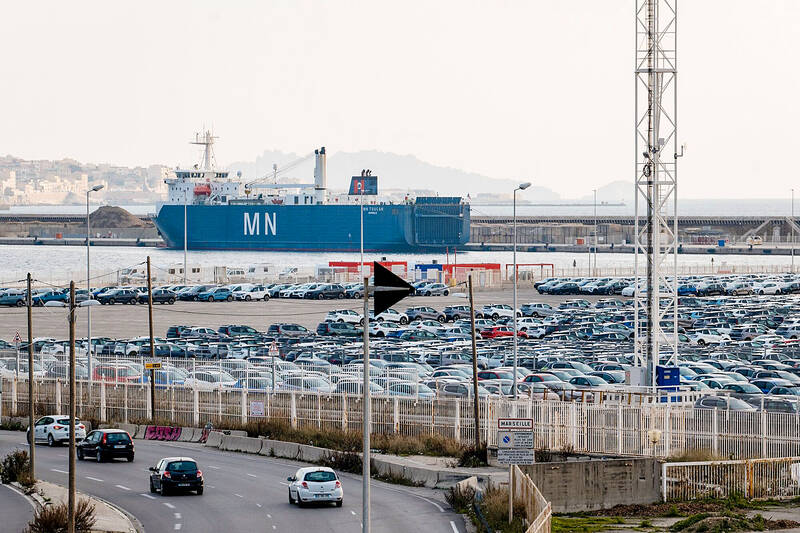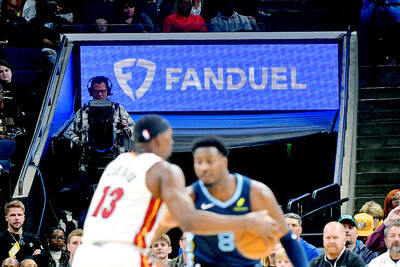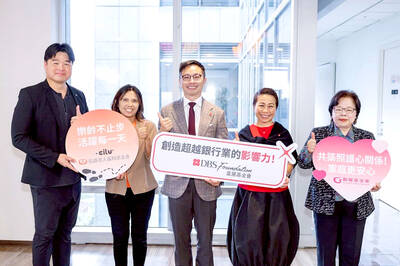US President Donald Trump on Tuesday said that he would likely impose tariffs on semiconductor, automobile and pharmaceutical imports of about 25 percent, with an announcement coming as soon as April 2 in a move that would represent a dramatic widening of the US leader’s trade war.
“I probably will tell you that on April 2, but it’ll be in the neighborhood of 25 percent,” Trump told reporters at his Mar-a-Lago club when asked about his plan for auto tariffs.
Asked about similar levies on pharmaceutical drugs and semiconductors, the president said that “it’ll be 25 percent and higher, and it’ll go very substantially higher over a course of a year.”

Photo: Bloomberg
Trump said he wanted to give companies “time to come in” before announcing new import taxes.
“When they come into the United States and they have their plant or factory here there is no tariff, so we want to give them a little bit of a chance,” he said.
New levies on automobiles would have sweeping effects on the industry. The about 8 million passenger cars and light trucks brought into the US last year accounted for about half of US vehicle sales. European automakers including Volkswagen AG and Asian companies, including Hyundai Motor Co, would be among the most affected.
Equities slipped across Asia when markets opened yesterday. In Taipei, the TAIEX closed down 62.03 points, or 0.26 percent, at 23,604.08, while Taiwan Semiconductor Manufacturing Co (TSMC, 台積電), the most heavily weighted stock, lost 0.91 percent to close at NT$1,090.
“Trump released more information on chip tariffs on Tuesday so it was no surprise that TSMC and the tech sector were impacted,” MasterLink Securities Corp (元富證券) analyst Tom Tang (湯忠謙) said.
“The silver lining is that the tariffs are not set to go into effect until April so there is some time for negotiations,” he added.
While there are scant details about the latest tariff threat, it is clear that the targets in Trump’s second trade war have broadened beyond China and would hit Asia in particular, Natixis SA chief economist for Asia Pacific Alicia Garcia Herrero said.
Globally, the countries most exposed to Trump’s latest announcement include Mexico and South Korea, where exports of passenger vehicles to the US are equal to 2.4 percent and 1.8 percent of GDP respectively, Bloomberg Economics data showed.
Auto making powerhouse Japan is also in the line of fire, particularly if recent levies are stacked with prior ones. Japan — where auto exports make up the largest chunk of outbound shipments and the US is the largest market — has already raised the issue with the White House.
“We have been raising the issue with the US government, given the importance of Japan’s automobile industry,” Japanese Chief Cabinet Secretary Yoshimasa Hayashi told a news conference yesterday. “Japan will first carefully examine the specific details of the measures that will come out and their impact on Japan, and then respond appropriately.”
When it comes to chips, Malaysia and Singapore are among the most exposed. Malaysia is the sixth-largest exporter of semiconductors and shipped out a record 601 billion ringgit (US$135.31 billion) of semiconductors last year.
Taiwan, a global powerhouse in semiconductor production that Trump has accused of stealing the US chip industry, also remained cautious.
“The scope of products subject to tariffs has not yet been clarified. We will continue to monitor the direction of US policies and assist Taiwan’s industries,” the Ministry of Economic Affairs said in a statement.
Taiwan’s government had previously said it would boost investment in the US as it sought to head off Trump’s duties.
EU Commissioner for Trade and Economic Security Maros Sefcovic is this week traveling to Washington to meet counterparts for a last-ditch effort to avoid getting hit by duties in April. However, Trump has signaled there is not much any one country can do to get out from the tariffs if he views the trading relationship as unbalanced.
“It seems like no one is really getting through this unscathed,” said Katrina Ell, head of Asia Pacific economies at Moody’s Analytics. “I hope they’re using them as a negotiating tool. What we know from the past is that these tariffs don’t work as Trump wants them to work.”
Additional reporting by CNA and AFP

Mercuries Life Insurance Co (三商美邦人壽) shares surged to a seven-month high this week after local media reported that E.Sun Financial Holding Co (玉山金控) had outbid CTBC Financial Holding Co (中信金控) in the financially strained insurer’s ongoing sale process. Shares of the mid-sized life insurer climbed 5.8 percent this week to NT$6.72, extending a nearly 18 percent rally over the past month, as investors bet on the likelihood of an impending takeover. The final round of bidding closed on Thursday, marking a critical step in the 32-year-old insurer’s search for a buyer after years of struggling to meet capital adequacy requirements. Local media reports

US sports leagues rushed to get in on the multi-billion US dollar bonanza of legalized betting, but the arrest of an National Basketball Association (NBA) coach and player in two sprawling US federal investigations show the potential cost of partnering with the gambling industry. Portland Trail Blazers coach Chauncey Billups, a former Detroit Pistons star and an NBA Hall of Famer, was arrested for his alleged role in rigged illegal poker games that prosecutors say were tied to Mafia crime families. Miami Heat guard Terry Rozier was charged with manipulating his play for the benefit of bettors and former NBA player and

The DBS Foundation yesterday announced the launch of two flagship programs, “Silver Motion” and “Happier Caregiver, Healthier Seniors,” in partnership with CCILU Ltd, Hondao Senior Citizens’ Welfare Foundation and the Garden of Hope Foundation to help Taiwan face the challenges of a rapidly aging population. The foundation said it would invest S$4.91 million (US$3.8 million) over three years to foster inclusion and resilience in an aging society. “Aging may bring challenges, but it also brings opportunities. With many Asian markets rapidly becoming super-aged, the DBS Foundation is working with a regional ecosystem of like-minded partners across the private, public and people sectors

BREAKTHROUGH TECH: Powertech expects its fan-out PLP system to become mainstream, saying it can offer three-times greater production throughput Chip packaging service provider Powertech Technology Inc (力成科技) plans to more than double its capital expenditures next year to more than NT$40 billion (US$1.31 billion) as demand for its new panel-level packaging (PLP) technology, primarily used in chips for artificial intelligence (AI) applications, has greatly exceeded what it can supply. A significant portion of the budget, about US$1 billion, would be earmarked for fan-out PLP technology, Powertech told investors yesterday. Its heavy investment in fan-out PLP technology over the past 10 years is expected to bear fruit in 2027 after the technology enters volume production, it said, adding that the tech would